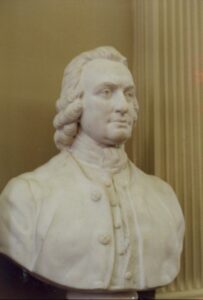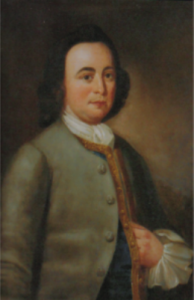George Mason (IV)
The famous George Mason IV, namesake of the university, was a fourth generation Staffordian. His great grandfather, George Mason I, left Staffordshire, England around 1652 and settled near the Potomac River. His home, Accakeek Farm, was located on the southeastern corner of today’s Brooke Road and Marlborough Point Road. (State Routes 621 and 608) All that is left of the farm is a family cemetery. It is thought that Mason’s great grandfather was responsible for naming the county Stafford from his homeland. George Mason’s grandfather, George Mason II, moved the family to Chappawamsic Creek and named the land Chappawamsic Farm. It was located east of state highway I, by today’s Hilldrup Transfer and Storage. George’s (IV) father, George III, was born at Chappawamsic Farm. He became a vast landowner. In 1735, when he died due to drowning, tax records indicate that he owned 20,875 acres in Stafford alone.
Just like George Washington, another Staffordian, George Mason lost his father when he was ten years of age. Like George, his mother never remarried. George Mason never had a formal education, but studied at his uncle John Mercer’s library located at Marlborough Point. This library was the second largest in Virginia.
In 1776, Mason served at the Virginia Convention in Williamsburg. It was here where he wrote the drafts of the first declaration of rights and a state constitution. After alterations, the Virginia Declaration of Rights was adopted on June 12th and the Virginia Constitution on June 29th.
Ten years later, in 1786, Mason was chosen to represent Virginia as a delegate to the Federal Convention. It was in Philadelphia where the convention met to revise the Articles of Confederation. Serving in 1787, from May to September, Mason helped create the Constitution. However, he refused to sign it as he felt it lacked a “declaration of rights.” At the Virginia Ratification Convention, delegate Mason, representing Stafford, again opposed signing the Constitution, for he felt there should have been a bill of rights. This put George Washington and him on opposite sides. It is said that both Georges were friends when younger, but this difference of opinion put a strain on their relationship. Washington was a federalist and believed in a strong central government. Mason on the other hand, being an anti-federalist, felt that states’ rights were paramount with a weaker federal or central government. Mason and others, like Patrick Henry, persisted and finally on December 15, 1791, the Bill of Rights, based on the Virginia Declaration of Rights, was adopted.
During the convention, Mason expressed his opinions quite frequently. As a matter of fact, he was one of five speakers who voiced beliefs most often. Despite enslaving people himself, he felt that slavery trade should be abolished. He also believed that the Church of England, or the Anglican Church, should not be part of the government.
Mason died in 1792 at Gunston Hall, in time to see the final adoption of the Bill of Rights.
Other Stafford ties:
- Mason’s home, Gunston Hall, was built of brick, but had Aquia Stone trim. The stone was found in quoins, chimney caps, and the water table. He also wrote to his son about using Aquia Stone for “chimney pieces” or mantels.
- Mason’s second wife, Sarah Brent, was from the same family that founded Stafford.


Bibliography:
- Conner, Al, A History of Our Own; Stafford, Virginia. Virginia Beach, VA: The Donning Company Publishers, 2003.
- Conner, Jane, Birthstone of the White House and Capitol. Virginia Beach, VA: The Donning Company Publishers, 2005.
- Eby, Jerrilynn, They Call Stafford Home. Bowie, MD: Heritage Books, 1997.

